a.rawlings: Ecopoetic intersubjectivity
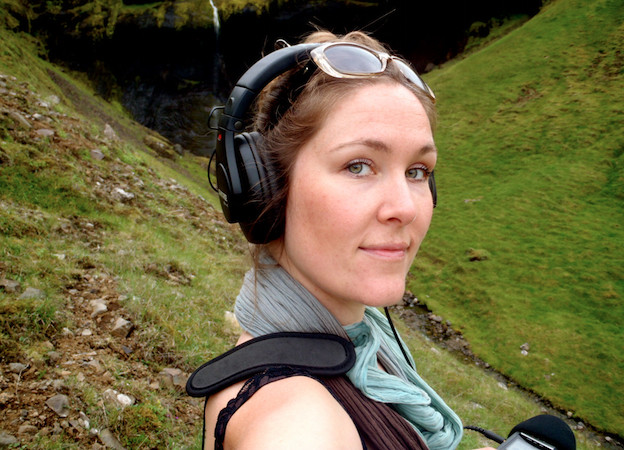
In a recent essay, “Learning the Grammar of Animacy,” Robin Wall Kimmerer, a botanist who is a member of the Potawatomi tribe (one of the Ojibwe or Anishinaabe peoples of North America), recounts being stunned when she learned of the word puhpowee from an ethnobotanical study on traditional Anishinaabe uses of fungi. In that word, which translates as “the force which causes mushrooms to push up from the earth overnight,” Kimmerer “could see an entire process of close observation in the damp morning woods, the formulation of a theory for which English has no equivalent. The makers of this word understood a world of being, full of unseen energies that animate everything.”[1] The essay describes her subsequent efforts to learn the Anishinaabe dialect Bodéwadmimwin or Potawatomi, a threatened language with only nine remaining fluent speakers in her tribe. Doing so proves extremely difficult, because that language differs so profoundly from English. Where English is noun-based, Potawatomi is seventy percent verbs. Moreover, in Potawatomi, both nouns and verbs are classified as either “animate” or “inanimate”: “Pronouns, articles, plurals, demonstratives, verbs … are all aligned in Potawatomi to provide different ways to speak of the living world and the lifeless one. Different verb forms, different plurals, different everything apply depending on whether what you are speaking of is alive.”[2]
The difficulties of learning were so great that Kimmerer was on the verge of giving up the frustrating struggle until a revelatory moment when she encountered the verb wiikwegamaa, which means “to be a bay.” She recalls:
In that moment I could smell the water of the bay, watch it rock against the shore and hear it sift onto the sand. A bay is a noun only if water is dead. When bay is a noun, it is defined by humans, trapped between its shores and contained by the word. But the verb wiikwegamaa — to be a bay — releases the water from bondage and lets it live. “To be a bay” holds the wonder that, for this moment, the living water has decided to shelter itself between these shores, conversing with cedar roots and a flock of baby mergansers.[3]
This language, she recognizes, is “a mirror for seeing the animacy of the world, the life that pulses through all things.” Potawatomi extends the grammar of animacy (not to be confused with the arrogance of at least some forms of anthropomorphism) not only to humans, nonhuman animals, and plants, but also to rocks and “mountains and water and fire and places.” In every sentence, its speakers are reminded of their kinship with all that the language establishes as the animate world. Currently, in teaching her ecology students, Kimmerer takes a bilingual approach, using both “the lexicon of science and the grammar of animacy.” She explains, “Although they still have to learn [the plants’] scientific roles and Latin names, I hope I am also teaching them to know the world as a neighborhood of nonhuman residents, to know that, as ecotheologian Thomas Berry has written, ‘we must say of the universe that it is a communion of subjects, not a collection of objects.’”[4] Kimmerer makes clear that she’s not advocating that we all learn Native American languages, but she does urge a transformation in conception and attitude that would allow us all to speak the grammar of animacy from our hearts. Internalizing that grammar, she suggests, “could well be a restraint on our mindless exploitation of land”; by enabling us to “[walk] through a richly inhabited world of Birch people, Bear people, Rock people, beings we think of and therefore speak of as persons worthy of our respect, of inclusion in a peopled world,” it would give us access to other perspectives and sources of wisdom.[5]
Currently environmental thinkers in a number of fields are working to reconceptualize and refigure the human relation to nonhuman life forms so as to better understand nonhuman modes of intelligence, perception, and communication; to correct anthropocentric biases; and to more accurately reflect species interdependencies.[6] A political hope behind these efforts is that such perspectival adjustments may help humans live in less destructive and more mutually beneficial relation to the rest of the biosphere. Because Anglophone experimental poetics for the past century has involved developing perspectives and poetic techniques designed deliberately to resist habitual ways of thinking and of ordering perception, contemporary ecopoets with experimental inclinations in North America, eager to push language in unaccustomed directions, see themselves as having a role to play in this interdisciplinary exploration. Although often basing their belief that language is inherently connected to perception and thought in constructivist understandings that emerge from poststructuralist theory, these poets seem very like Kimmerer in investing themselves in using the powers of language to initiate what Forrest Gander calls “a reorientation from objectivity to intersubjectivity.”[7]
Joan Retallack, for instance, in her essay “What is Experimental Poetry and Why Do We Need It?,” observes that “The human imagination has always done a brilliant job of occupying the ‘empty spaces’ of alterity.” She proposes that having inherited “a monodirectional dynamic of voluble us and silent them,” poets need to find “a reciprocal alterity” by engaging in the “hard work of acquiring accurate [scientific] knowledge” and combining that with an experimental stance which may free us from our anthropocentric preconceptions. “The very word ecopoetics,” Retallack suggests, “may be seen as an experimental instrument that creates a new order of attention to the possibility of a poetics of precise observations and conversational interspecies relations with all contributing to the nature of the form.”[8] We might well debate the extent to which such reciprocity is possible, since it’s not clear how much we humans are capable of hearing nonhuman voices, but approaches to language that foster the kind of attitudes Kimmerer locates in a “grammar of animacy” may bring us closer to the respectful and equitable connection Retallack envisions.
As much of the work recently collected in The Arcadia Project: Postmodern Pastoral or published in the online journal ecopoetics makes evident, Retallack is not alone in seeing experimental poets as having important work to do in seeking what she calls “correctives to ‘nature’ narratives of segregation, dominance, and nostalgia” which “[fail] to acknowledge ‘them’ as inextricably intertwined with ‘us.’” Angela Rawlings, a Canadian poet and performance artist who publishes as a.rawlings, would seem to take a similar view, and it is her 2006 book Wide Slumber for Lepidopterists that I will examine in this essay, to demonstrate some of the ways in which experimental poetics — in their alternative approaches to poetic subjectivity, emphasis on the materiality of language, and resistance to the conventional regulations of thought encoded in standard syntax and other conventional literary structures — might be helping shift our sense of human/nonhuman relations away from the anthropocentric and might enhance our sense of kinship and interdependence with other life forms.
In a.rawlings’s book this shift is enacted through extraordinary attention to and representations of embodied sensation. There is a relevant passage in J. M. Coetzee’s novel Elizabeth Costello in which the title character, objecting to the implication in Descartes’s assertion “Cogito, ergo sum” that “a living being that does not do what we call thinking is somehow second-class,” offers the following: “To thinking, cogitation, I oppose fullness, embodiedness, the sensation of being — not a consciousness of yourself as a kind of ghostly reasoning machine thinking thoughts, but on the contrary the sensation — a heavily affective sensation — of being a body with limbs that have extension in space, of being alive to the world.”[9] Wide Slumber for Lepidopterists, I believe, works to create just that kind of sensation for a body that may be human and/or may be lepidoptoral, as the lines between these species often blur. The text fosters biocentrism not just in what it suggests about common somatic experiences shared by human and nonhuman species but in what it does to language itself: in highlighting the physicality of both sounding and reading words, and in making language evidently participate in the processes of the biosphere — processes of predation and consumption, of metamorphosis and decay, of reproduction, development, and evolution.
Even as I make those claims, I wish to acknowledge that what constitutes anthropocentrism and what biocentrism may not be easy to discern, and that the latter may remain an ideal that humans cannot fully achieve. Certainly, the act of blurring distinctions between human and nonhuman animals, dependent as it is on imagining nonhuman experience, may itself involve anthropocentric human projection; Kate Soper wisely cautions against valuing such blurring for its own sake.[10] Yet one can persuasively argue, as Val Plumwood does, that anthropocentrism is rightly understood as distinct from “epistemic locatedness”: she contends that the latter, which is inescapable, does not preclude empathy or the overcoming of a narrow restriction of ethical concern to the self.[11] Plumwood asserts, “to the extent that anthropocentric frameworks prevent us from experiencing the others of nature in their fullness, we not only help to imperil ourselves through loss of sensitivity but also deprive ourselves of the unique kinds of richness and joy the encounter with the more-than-human presences of nature can provide.” Harmonizing with Retallack (and, I think, pointing to what a.rawlings enacts), Plumwood proposes that we “need a reconception of the human self in more mutualistic terms as a self-in-relationship with nature, formed not in the drive for mastery and control of the other but in a balance of mutual transformation and negotiation.”[12]
Coetzee’s Elizabeth Costello asserts “there is no limit to the extent to which we can think ourselves into the being of another. There are no bounds to the sympathetic imagination.”[13] This character, a novelist like her creator, claims she can think her way “into the existence of a bat or a chimpanzee or an oyster, any being with whom I share the substrate of life”;[14] she asserts that Ted Hughes does that in some of his animal poems, which she says don’t inhabit another mind but rather another body.[15] Her mention of a bat is part of her attempt to refute the contrary view of Thomas Nagel in his widely known philosophical essay “What Is It Like to Be a Bat?”[16] Nagel points out that because our own experience as humans provides the basis for our imagination (Plumwood’s “epistemic locatedness”), its range is limited. I can imagine “only what it would be like for me to behave as a bat behaves” but not what it is like for a bat to be a bat, Nagel argues. He sensibly reasons that the experience of any species has “a specific subjective character, which it is beyond our ability to conceive,” and that “if extrapolation from our own case is involved in the idea of what it is like to be a bat, the extrapolation must be incomplete.”[17] Granting that, I would suggest that perhaps our necessarily partial imaginings can nonetheless help us see the world differently. In a footnote, Nagel himself admits,
It may be easier than I suppose to transcend inter-species barriers with the aid of the imagination. For example, blind people are able to detect objects near them by a form of sonar, using vocal clicks or taps of a cane. Perhaps if one knew what that was like, one could by extension imagine roughly what it was like to possess the much more refined sonar of a bat. The distance between oneself and other persons and other species can fall anywhere on a continuum.[18]
Plumwood, like Costello, is less daunted by species difference. Noting that many ethical theories regard moral reasoning itself as requiring “some version of empathy, putting ourselves in the other’s place, seeing the world to some degree from the perspective of an other with needs and experiences both similar to and different from our own,” she argues that human-centeredness is “no more inescapable than any other form of centrism,” such as ethnocentrism or androcentrism.[19] In thinking about establishing ethical relations to the nonhuman world, she advocates breaking down the human-nature dualism that “configure[s] the world rigidly in terms of human and other” rather than “expand[ing] the category of privilege to take in a few of the more human-like non-humans.”[20] Issues of (un)ethical relations to nonhuman animals, as we will see, enter into Wide Slumber for Lepidopterists,but they are not its central concern; rather, the kind of respectful and reciprocal engagement with other life forms based in — or taking place through — the body that Costello proposes, and that aligns with both Plumwood’s and Kimmerer’s senses of how we may move forward in addressing the current ecological crisis, is central to a.rawlings’s exploration of interspecies identifications.
As I will demonstrate shortly, in Wide Slumber for Lepidopterists a.rawlings does generate species blurrings and “mutual transformations” between Homo sapiens and Lepidoptera, yet she also maintains her readers’ respect for the differences between butterflies or moths and humans. Respect for difference is made easier by her not having chosen to “think with” (in Lorraine Daston and Gregg Mitman’s punning phrase) one of the charismatic megafauna, by not choosing a species that is large-brained, readily imagined as neotenic, frequently linked to a particular human trait (as is the case with the “sly fox,” say), or even associated with aspects of animality recognized — and often deplored — in the human.[21] With the exception of the monarch butterfly, the order of Lepidoptera hasn’t much caught the popular environmental imagination, and this, along with the marked differences between insect and mammalian anatomy, makes the creatures’ alterity easier to respect than might otherwise have been the case. Conversely, generating a sense of what Kimmerer speaks of as kinship may be correspondingly difficult, yet through an intense collaging that prevents clear separation of human from lepidopteral experience, a.rawlings manages it. By revealing correspondences and overlaps between human experience and admittedly presumed or imagined, even if scientifically informed, butterfly experience, a.rawlings challenges some of the ways in which we Western humans set ourselves apart from other animal life; through its densely disjunctive, highly sensory techniques, her work fosters the appreciation of connectedness and commonalities among life-forms that a grammar of animacy conveys.
Wide Slumber for Lepidopterists is a dazzlingly metamorphic volume that manipulates visual images and text to explore embodiment and various forms of eroticism; the life cycle of Lepidoptera; the practices of lepidopterists (particularly the collection and mounting of specimens); the stages of sleep; the study of sleep and sleep disorders; and the analysis of literary texts. According to an interview, it was prompted by a.rawlings wondering: “if a poet writes poems during sleep, how might a lepidopterist work while she sleeps? What effect does intimate examination of insects have on long-term information processing and subconscious behaviour?”[22] It originated, then, from speculations on human consciousness, but more specifically on the human as it may be affected by intimacy with the nonhuman.
In this book sensory experience is foregrounded — suggesting how much consciousness, at least in sleep, is a somatic phenomenon — and not just through the book’s verbal/semantic content but also through its reliance on visual forms of communication. Visual elements, then, are one means by which the work very evidently calls upon not just cogitation, but, as Elizabeth Costello puts it, the sensation of being. On the cover appears what I have identified as a Northern Pearly-eye butterfly (Enodia anthedon) whose body aligns with the spine of the book so that one set of wings folds over each cover.
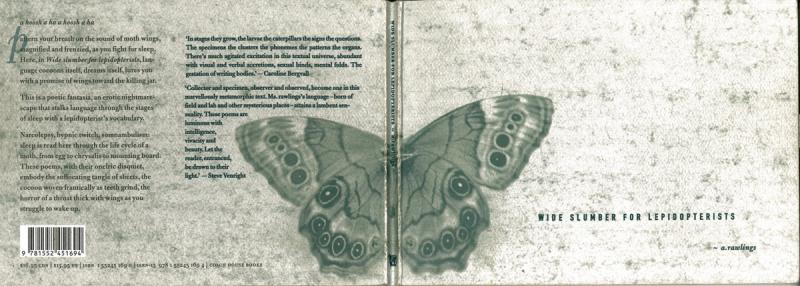
Front cover from Wide Slumber for Lepidopterists, © a.rawlings (words), Matt Ceolin (illustrations), published by Coach House Books, 2006. Reprinted with permission from Coach House Books.
This is the first of more than a dozen images that appear in the book, all by a.rawlings’s collaborator Matt Ceolin, most of which represent butterflies or moths either dead or in various life stages.
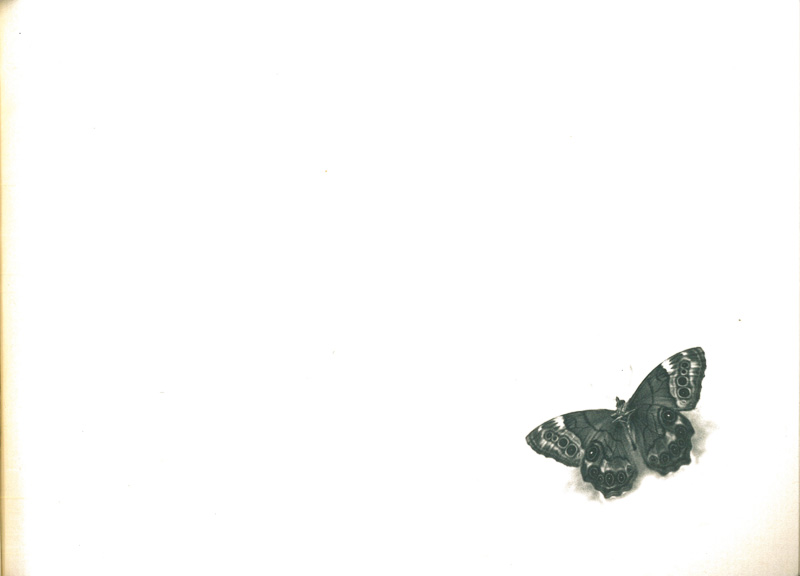
First page from Wide Slumber for Lepidopterists, © a.rawlings (words), Matt Ceolin (illustrations), published by Coach House Books, 2006. Reprinted with permission from Coach House Books.
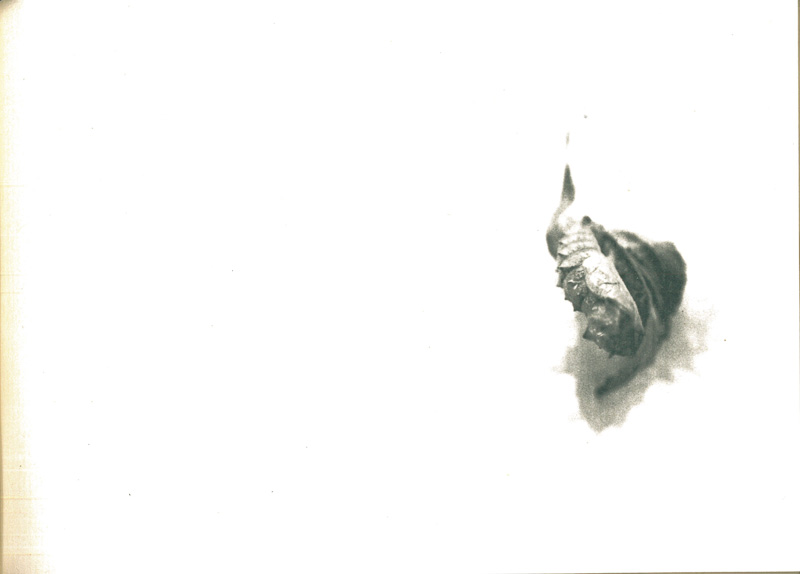
Page 19 from Wide Slumber for Lepidopterists, © a.rawlings (words), Matt Ceolin (illustrations), published by Coach House Books, 2006. Reprinted with permission from Coach House Books.
These images invite attention to lepidopteral bodies. Additionally, there are three images of jars and bottles that would be part of the lepidopterist’s equipment, including a stoppered bottle containing a butterfly specimen; one image of a book opened to a schematized image of a butterfly with labeled parts; and another image that presents a similar schematized drawing without representing a book.
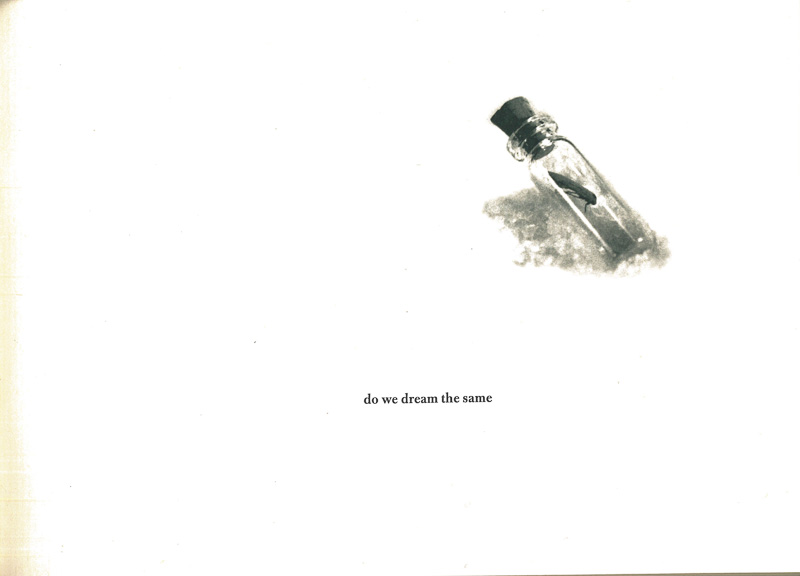
Page 51 from Wide Slumber for Lepidopterists, © a.rawlings (words), Matt Ceolin (illustrations), published by Coach House Books, 2006. Reprinted with permission from Coach House Books.
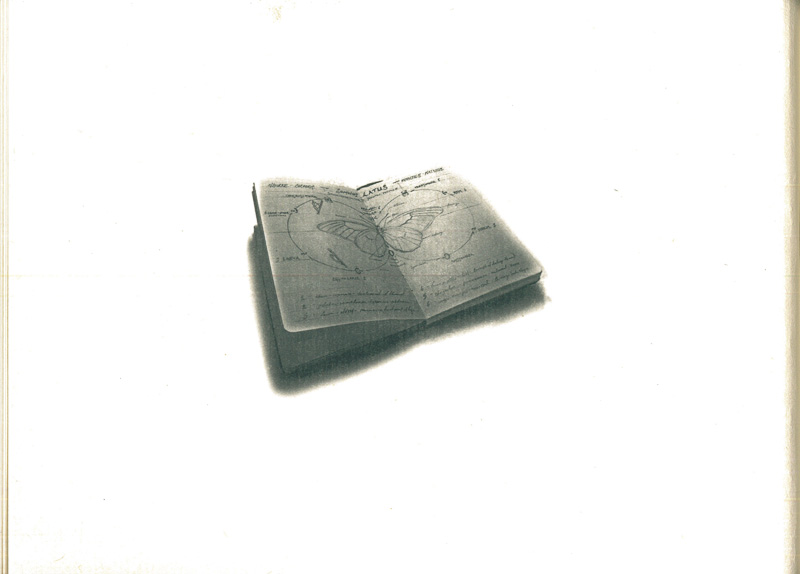 Page 95 from Wide Slumber for Lepidopterists, © a.rawlings (words), Matt Ceolin (illustrations), published by Coach House Books, 2006. Reprinted with permission from Coach House Books.
Page 95 from Wide Slumber for Lepidopterists, © a.rawlings (words), Matt Ceolin (illustrations), published by Coach House Books, 2006. Reprinted with permission from Coach House Books.
These visuals remind the reader that Western humans have typically sought knowledge of Lepidoptera by killing them so that they can be collected, categorized, and either dissected or preserved.
More experimentally, the text is arranged in remarkably various eye-catching visual arrangements. Sometimes these provide a kind of scoring of the breath in the tradition of projective verse, and sometimes spatial arrangement coupled with variation in font highlights the juxtaposition of different kinds of discourse; but much of this visual variety turns pages into object of visual art whose visual meaning — beyond an insistence on the absence of a standard arrangement — is difficult to discern. Some page designs in which appear not just words but letters or letter combinations or keyboard symbols suggest concrete poetry, as when facing pages look like open butterfly wings. Thus, on four pages associated with “Bruxism,” “a parasomnia where the sleeper grinds or clenches her teeth,”[23] near mirrorings of text create a wing-like design made of bold face and regular typeface words, and of clusters of letters with isolated consonants scattered at the edges. It’s appropriate to “bruxism” that these are mostly the “dental” consonants t, d, n, l, made with the tongue against the teeth.[24] The words on the left-hand pages are disjointed fragments of English — mostly nouns and adjectives, perhaps from dreams or nightmares — on the right, equally disjunct parts of Latin names for species of moths or butterflies (68–71).
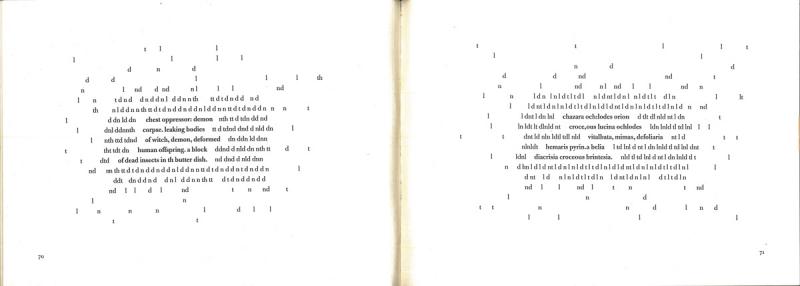 Page 70–71 from Wide Slumber for Lepidopterists, © a.rawlings (words), Matt Ceolin (illustrations), published by Coach House Books, 2006. Reprinted with permission from Coach House Books.
Page 70–71 from Wide Slumber for Lepidopterists, © a.rawlings (words), Matt Ceolin (illustrations), published by Coach House Books, 2006. Reprinted with permission from Coach House Books.
These wing-like textual designs might be considered a crude example of a.rawlings using language as bioform, making pages into butterflies — though we might equally well read this as highlighting the textually mediated character of our knowledge of butterflies, the distance between representation and the living animal. In a more compelling instance of displaying language as part of the biosphere, a tightly curled caterpillar of text gradually uncurls and moves to the right over a few pages. In the process its letters modulate from reading “count by slumber” to “faint bystander” to “pant by number” to “cunt by umber” (that last term evoking the umber moths) to — when the text is flat — “ti ur tor foknur” (where “tor” as anagrammatic “rot” seems potentially significant) so that this textual creature doesn’t just crawl, it develops in the process of its own motion through space and time.
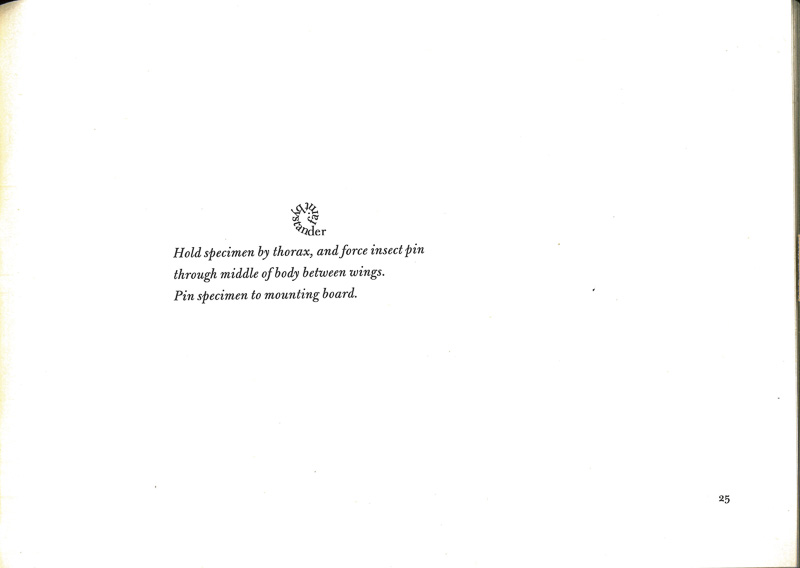 Page 25 from Wide Slumber for Lepidopterists, © a.rawlings (words), Matt Ceolin (illustrations), published by Coach House Books, 2006. Reprinted with permission from Coach House Books.
Page 25 from Wide Slumber for Lepidopterists, © a.rawlings (words), Matt Ceolin (illustrations), published by Coach House Books, 2006. Reprinted with permission from Coach House Books.
 Page 27 from Wide Slumber for Lepidopterists, © a.rawlings (words), Matt Ceolin (illustrations), published by Coach House Books, 2006. Reprinted with permission from Coach House Books.
Page 27 from Wide Slumber for Lepidopterists, © a.rawlings (words), Matt Ceolin (illustrations), published by Coach House Books, 2006. Reprinted with permission from Coach House Books.
Elsewhere letters progressively vanish from the text, leaving tattered remnants of words as if eaten out, again giving material language a kind of organic life as it participates in processive change. Retallack in her essay adapts John Cage’s thinking to propose as one experimental ecopoetic strategy “adopting nature’s manner of operations,” and the practices I have just described can be understood as linguistic versions of just that. Even when analogues to biological processes are less clear, as when recognizable words are suddenly replaced by illegible clusters of letters which may or may not be anagrammatically decipherable, language in this book tends to be a markedly unstable, rapidly evolving material — and the visual qualities of this text contribute crucially to that animation. A readily visible textual instability is key to what makes this book difficult to process in conventional ways, and its asking us to see and experience the lepidopteral in unfamiliar ways is, I think, fundamental to the poem’s experimental attempt to reposition humans and human epistemology in relation to the life-forms humans have categorized as Lepidoptera.
Like the visual elements, sounds also enrich the sensory quality of a reader’s experience of Wide Slumber for Lepidopterists. For instance, in sounding those dental consonantsjust mentioned, the reader is forced to be much more aware of tongue and teeth than in usual reading experiences.a.rawlings often employs conventional techniques like alliteration and assonance in ways that heighten readers’ consciousness of their own embodiment. In her hands, even such traditional poetic devices serve unsettlingly to defamiliarize human somatic experience and to blur its distinctions from that of the moth or butterfly. A brief example: “wood nymphs spin and hang crude cocoons // we hold our slow high flight” (15). Here’s a more extended example, the lower half of an unbroken page:
our wings our breath
heavy as wails, our wet
soul, sail, th gall of th ‘th,’th ‘of’ of th ‘of’ or th ‘th,’ th
ways lips hug proboscis th vulva, yes, th vulva
water is fire protrusion velour
penetration vellum
chrysalistalization dark valium
row of fine-lipped, of
up tubular, a
thin (65)
Clearly, the echoing and modulating sounds — for instance, of proboscis, protrusion, and penetration (which could be read downward in immediate succession), or of vulva, velour, vellum and valium — give these lines a sensual richness on the tongue. But beyond that, partly through the progression and dissolution of sound patterns as well as through its visual design, the passage enacts a shift from what seems a clear distinction between species — “our wings” (which belong to butterflies and not humans) on the left-hand side of the page, “our breath” (produced by humans and not butterflies) on the right-hand side — to a confusion of bodies. Either breath or wings could be heavy and wet, and both have associations with the soul (as the soul passes — or flies — from the mortal body with its last breath), though a term like “wails” would seem to designate sounds not, to our knowledge, made by insects. The line of “of”s and “th”s could sound like either panting breath or the movement of air with a fluttering of wings. The insect’s alliteratively stressed protruding proboscis penetrates flowers, but the human vulva might also be the entryway of penetration, while the lips here seem human as well, whether associated with the mouth or with female genitalia. Perhaps these lines suggest an analogy between the butterfly’s pleasure in feeding and the human’s pleasure in sexual penetration. Perhaps they point to commonalities between the objectified position of the female in a patriarchal order and that of the butterfly in an anthropocentric one. Going further in their imagining, perhaps these lines attempt to bring sensually alive for us the experience of an insect feeding, sticking that thin proboscis up the velvety softness of a tubular flower.[25]Certainly, a first-person plural that is not appropriative but inclusive (a useful distinction Retallack offers) is created here, one that acknowledges a commonality of embodiment, hunger, and desire, but does so within a context of recognizing also mutual alterity. Flying remains quite fundamentally different from breathing, and vice versa.
That sound plays an important role in this poem’s blurring of the bodies and bodily experiences of butterflies or moths and humans is evident from the book’s opening pages. The first four pages of verbal text (that is, the pages that follow immediately after the dedication “To Northern Ontario,” a page of translucent vellum, and one with a small drawing of a Northern Pearly-eye), contain only the phrase “a hoosh a ha,” which is repeated different numbers of times and arranged differently on each page to map varying rhythms and increasing speeds with which the phrase is articulated. To designate those syllables a “phrase” is misleading since they seem closer to a sounded breath or breaths, inhalations and exhalations. a.rawlings’s 2007 performance of those pages (designated “Prologue”) at PennSound is eerily ambiguous in its humanity/inhumanity. While her voice dominates, one hears multiple voices, male as well as female, and the sounds, including some squeaks, don’t strike the ear as necessarily human.[26] “A hoosh a ha” might well mimic the sounds butterfly or moth wings make as they move through the air, as heard by ears or other hearing organs finely tuned enough to register their being raised and lowered. (As hearing organs, Lepidoptera have tympanal membranes on their wings. They are sensitive to sounds made by predators — birds in the case of butterflies, which are active in the day, and bats in the case of moths, which tend to be nocturnal.) In a.rawlings’s recorded reading, those pages take on a highly sexualized character, as if the being “hoosh”ing were approaching and then reaching orgasm before subsiding into stillness. Perhaps, though, one could imagine the sounds to register the gathering of more and more butterflies who, once assembled, come to rest. The Northern Pearly-eye does gather in large groups, particularly in the cooler, northwestern-most portion of its range.
Let me briefly recap my argument so far: In considering visual and aural elements of Wide Slumber for Lepidopterists,I have demonstrated that they generate a reading experience that requires of the reader a degree of sensual and somatic involvement unusual even in poetry, which is widely viewed as the literary genre in which the material qualities of language play the largest part, for instance through rhyme and meter. This emphasis on embodied experience draws readers toward aspects of our being we share with nonhuman animals (or sometimes plants, as might be suggested, for instance, by reference to the scent of honeysuckles as “honeysuckle sweat”) and away from the rational cognitive functions traditionally thought to distinguish the human. I have argued, too, that the insistently dynamic or metamorphic character a.rawlings gives to both sounded words or letters and their visual arrangement also contributes to her unsettling of conventional distinctions between human and nonhuman species, perhaps even — in giving an unusual life to letters — between the biotic and nonbiotic realms.
Metamorphosis — particularly multistaged metamorphosis — also provides the basis for the book’s structure, and exploring this structurally embedded thematic further will allow me to more fully develop my argument about the poem’s creation through poetic experimentalism of a grammar of animacy that imaginatively approaches reciprocal alterity.
The book has six sections, in each of which a lepidopteral life stage is explicitly linked with a stage of human sleep or a category of sleep disturbance: for instance, the first section is “EGG — INSOMNIA,” the next “EGG, LARVA — DYSSOMNIA,” the third “LARVA — NREM,” and so forth.[27] Each page announcing a new stage includes a typographic symbol or combination of symbols; one effect of these is to foster more inclusive thinking about languages by signaling that communicative systems need not involve words.
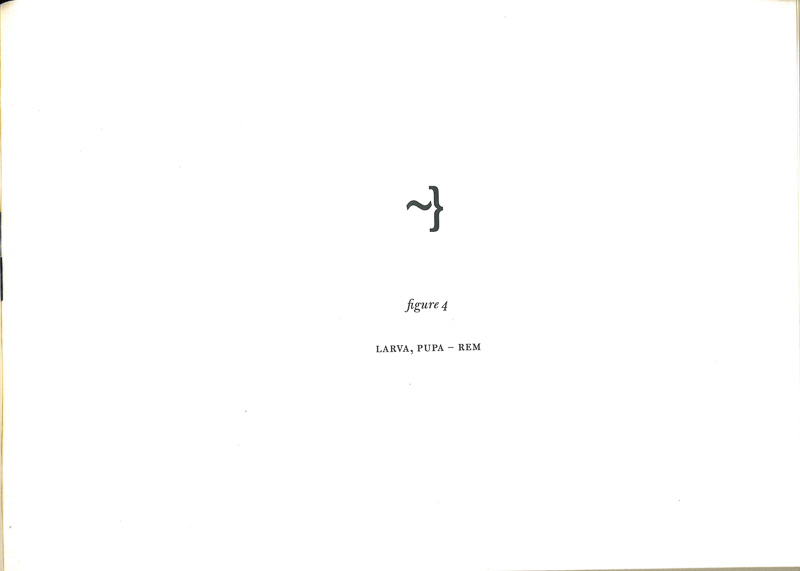 Page 49 from Wide Slumber for Lepidopterists, © a.rawlings (words), Matt Ceolin (illustrations), published by Coach House Books, 2006. Reprinted with permission from Coach House Books.
Page 49 from Wide Slumber for Lepidopterists, © a.rawlings (words), Matt Ceolin (illustrations), published by Coach House Books, 2006. Reprinted with permission from Coach House Books.
Four of the poem’s sections — all except the ones titled “LARVA, PUPA — REM” and “IMAGO — AROUSAL” (the imago being the adult winged form of Lepidoptera) — contain pages where the name of a sleep stage or disorder, such as “sleep spindles,” “apnea,” or “somnambulism,” appears in small capital letters on the lower outside corner near the page number. According to the description on the book’s back cover, “sleep is read here through the life cycle of a moth.” While a.rawlings presumably authorized that statement and while it accords with her description, quoted earlier, of the origin of the work, it does not accord with my readerly experience. The book does not seem to me to be more about sleep than it is about moth life; the two are thoroughly intertwined so that the book is about both, and also about their construction in language and their examination by science. Sleep seems to me where humans come closest to the kind of metamorphosis butterflies undergo rather than, say, the gradual development from infancy to adulthood. When we sleep, without our choice our brains and bodies enter distinct states with different modes of experience or consciousness. The book’s structure, then, emphasizes the analogous ways in which humans and butterflies undergo change through successive bodily transformations not subject to cognitive control. And in fact, after I shared with the author an earlier version of this essay that made these claims, she responded, “Yes, I approved the back-cover copy. However, I thought I’d mention that I am in agreement with your experience of the book. My experience writing it was that there was no intended hierarchy of one subject over another. Indeed, it could be said that sleep is read through the moth’s life cycle, but the inverse is equally valid — the moth’s life cycle can be read through sleep.”[28]
The experience of reading Wide Slumber for Lepidopterists, certainly fascinating and stimulating, is unsettling and at times quite disturbing as well. The back cover identifies the book as “an erotic nightmarescape.” That disturbance is provoked partly by what is presented in the book’s content, which is what the anonymous blurber seems to have in mind: horrifying evocations of moths caught in one’s throat, for instance. But it is also produced by the unpredictable ways “words breed” (81), suggesting uncontrolled genetic modifications. More generally, discomfort arises because the reader’s orientation is so precarious, and any sense of cognitive mastery so ephemeral.[29] Beginning with the very first lines after the (“ah hoosh a ha”) prologue, the reader has to accept or in some way accommodate a condition like the illogic of dream narrative. Here are those opening lines:
We descend on a field by a lake. a hoosh The lupin, sleep, the fog. a ha Fireflies, silent moths. We bury our legs in sand. Sound through the sand is dormant. We desire sleep to enter, virginal.
We stretch our feelers toward a warm body. a a Slowly, hands fog-damp spin plants, form air-filled hollows, breath cocooned, fur soft and blurred, heavy even heavenly. hoosh Soft like quiet. ha
Soft like we quiver (14)
The first-person plural speaker might well, at least initially, be lepidopteral, but the perspective seems to me ambiguously human as well. Perhaps the writing moves between the two species’ experiences, perhaps it joins them, but certainly the reader’s impulse to separate human neatly from Lepidoptera is effectively thwarted. Once the reader relinquishes the quest for categorization, she or he can appreciate that whether the legs in sand or the desire for sleep belong to one species or both, the bodies with hands and/or feelers occupy the same dreamily fog-filled field and possess a similar soft vulnerability. They share not only the natural environment of this summer evening in (if the dedication locates the work) Northern Ontario but also a desire for a change in somatic state to involve both sleep and sexualized bodily contact.
Similarly, the page that follows begins with the clearly human action and predominantly human perspective of “Slow light touch of hand on wing, scales brush off like butterfly kisses” (the anthropomorphizing name we give to the human act of brushing one’s eyelashes against another’s skin), but shortly, when “we tongue our shell, our conch,” “we” seems to speak also for larvae eating the eggshells from which they emerged and then acquiring nutrition from plants “with tongue buried deep in the suckle the honey” (15). The we subsequently becomes even more intensely indeterminate with the eroticized language that accompanies “the story’s arousal”:
we are taut while we thrust against the inner wall. Sleep is bruised or screams or none comes but we desire, we feel the full hot flesh of our wing swipe grass, scrape sand, we push ourselves out of ourselves, into our sound our hand our sweet wet hot our path, mourn, rake, master or muster. Glisten, swell come and the story’s arousal, twenty eyes unblink when the sun’s awake and even when it’s not the brain speaks, screams, swells and huge battened eyes of a hundred hungry mouths, no moths, wait this will move. (16–17)
As the first-person plural pronoun gathers in the reader as well, s/he is drawn into an experience that seems both the human progress toward the “sweet hot full the electricity” of orgasm and the compound-eyed moth’s effortful emergence from an earlier stage of itself, the pupa.
If we readers cannot distinguish human from butterfly desire or human from butterfly arousal here, and if we have to acknowledge that both are present, then we no longer have the hierarchical vantage implicit in an anthropocentric perspective. If, prompted by this dense weave of words — the text’s grammar of animacy — we have imaginatively entered a state where human and lepidopteral experiences, equally defamiliarized, interpenetrate without our losing awareness that there also exist significant differences between insects and mammals, we may be approaching something like the potentially conversational mode of reciprocal alterity that Retallack was envisioning.
This is a remarkable achievement that avoids problematic perspectives common in conventional nature poetry representing animals, but before closing I want also to contemplate its ecopoetic limits and perhaps limitations. I noted earlier that in its focus on somatic commonalities between humans and insects, Wide Slumber for Lepidopterists draws readers away from the rational realm that, most would agree, humans do not share with moths. The sensory experiences a.rawlings invokes often involve primal activities such as eating or sex or moving between involuntary stages of being, and they often assume a violent cast. Consequently, a.rawlings may be playing into some very old, derogatory thinking about animality. It’s hardly news that both humans and nonhuman animals have sexual drives in common; one could even see the work, particularly through its violence, as reinforcing traditional problematic linkages of the animal with “lower” functions. For the most part, I’d say that is not the case, because the “higher” functions do enter this animalized text through alphabetic language, and that realm is rendered thoroughly metamorphic and material. a.rawlings’s reinforcement of how much we humans are our bodies even in such an “elevated” and distinctively human trait as our ability to invent sign systems, moreover, supports environmentalist thinking to the extent that environmentalism requires recognizing our embodied dependence on and embeddedness in ecosystems. In most of this volume, a.rawlings’s presentations are too mobile, too multifaceted and multiperspectival, to allow any sense of the human apart from the dense linguistic environments she creates in which plant, human, and nonhuman animal bodies as well as alphabetic ones are dissected, joined, pinned, caressed, torn, transformed, and thoroughly entangled. The reader experiences a harsh realm of richly various biorhythms where myriad changing life forms come in contact and interact in ways often full of desire.
Yet it’s also true that through her presentation of the work of lepidopterists, which I’ll now examine, a.rawlings at points maintains a dualistic perspective that separates out and rejects the rational mind. For me, this undercuts some of the valuable integrative and expansive work done by Wide Slumber. Beginning in the section that follows the passages I examine above (all in the EGG — INSOMNIA section), a.rawlings introduces a contrasting perspective: that of the nondreaming lepidopterist, visually distinguished by the use of italic font.[30] She incorporates what appear to be selections from a set of instructions for those seeking the kind of epistemological control that is expressed in tidy taxonomies. Inserted into the poem in documentary fashion are instructions for how to “collect, kill, and mount specimen[s]” (23), such as
Manipulate wings simultaneously to avoid twisting body.
Pin wings to mounting board.
[…]
Pin wings near large veins to avoid tears.
Place paper over wings to prevent curling while drying. (26–27)
or
Keep mounted specimen in low-moisture condition to prevent mould.
Avoid direct sunlight to prevent fading.
Store in tightly closed box with insecticide to prevent dermestid beetle larvae
and book lice from feeding on body parts. (29)
These passages associate lepidoptery and scientific investigation with a fixing that is counter to the processes of life and of ecology, a common complaint about scientific “objectivity.” Not only do those collecting specimens engage in killing live creatures, but they then deliberately remove those creatures’ bodies from the cycles of decay and of nourishing other species in which they would otherwise participate. a.rawlings makes these implied, familiar judgments more interesting by implicating the reader in analogous processes. Poetry critics, the text warns us, can enact a similar destruction. Paralleling those who “Pinch thorax between thumb and forefinger. / Slide specimen into envelope; store in box with insecticide”(23) are those who wish to “Collect, sort and frame text … Pinch meaning between morpheme and phoneme … Slide meaning into envelope; store in box with semanticide”(42). In presenting this common popular critique of literary study and paralleling it with a critique of the science of lepidoptery, a.rawlings puts at least certain forms of intellectual activity at odds with the pleasure in Costello’s “sensation of being.”
On the facing page, which has as its sleep term in the bottom corner “restoration,” a.rawlings offers a set of italicized instructions that return us to the alternative approach taken by the bulk of her poem. Notably, though perhaps not murderous, these instructions have their own violence. They involve forcefully manipulating the text so that it becomes an active medium that does things, or they involve doing things to the text that defamiliarize and reveal it more truly:
Force a pen through the body of the text.
Translate texts simultaneously to twist meaning. Pen words on bed frame.
Pen anagrams on mirror.
Pin words near vowels to avoid tears. Place paper over words to curl while drying.
Watch text uncurl dusk.
Place punctuation under lamp to increase integrity. (43)
(Tears as in ruptures on the left-hand page may become tears as in liquid released in weeping on the right, an example of the kind of fruitful multiplicity or fluidity of meaning this writing generates.) It would be reductive, then, to suggest that the experimental writer’s activities are positioned in simple opposition to the scientist’s. Still, the scientist, at least as specimen collector, is the one presented as invested in knowledge at the expense of life.
One way to understand later pages that list fragmented Latin names for butterflies, or pages that turn lists of lepidopteral pupae or larvae into a kind of rhythmic chant (“tiliae larva nd smerinthus ocellata larva nd hemaris fuciformis larva nd cerura vinula larva nd notodonta dromedaries larva nd ptildontella cucullina larva” [86]), is to see a.rawlings forcing her pen through the body of lepidoperists’ foundational text: Linnaean classification according to classes, orders, genera, and species. In a similar gesture, she performs transformative twists onthe line “Welcome to the Centre for Sleep and Dream Studies,” gnawing away at its words to reveal other possibilities they contain: “Welcome to th // Enter. Sleep nd ream. elcm” (24).
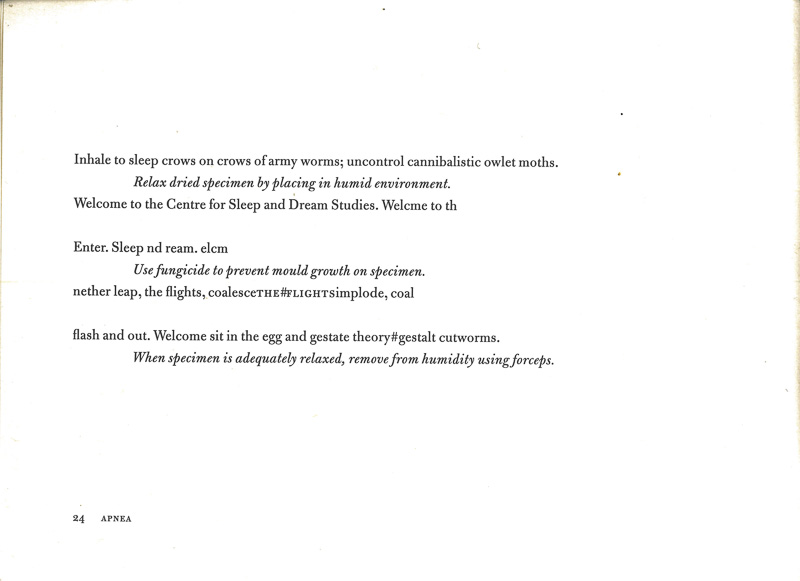
Page 24 from Wide Slumber for Lepidopterists, © a.rawlings (words), Matt Ceolin (illustrations), published by Coach House Books, 2006. Reprinted with permission from Coach House Books.
Opposing herself to the dissective activity of much science, but not denying destructive aspects of her own practices, a.rawlings uses scientific terms for productive verbal and conceptual metamorphosis; as the text reports at one point: “spit words split worlds.” There’s a feminist dimension to this activity as well: there are clear suggestions in the text that women and their bodies are labeled, collected, violently pinned, and in several senses mounted (“does th vahlvã speak / how does th vulvaw speak” the text asks [62], evoking Gayatri Spivak’s subaltern). Women are another Other whom the book challenges us to perceive more fully and more fluidly. Yet here again, the text does not escape reliance on a predictable problematic binary, in this case one that identifies the fluid and multiple as feminine and the rigidly rational as masculine; to the extent it does so, it threatens the egalitarian spirit essential to both animacy and the creation of reciprocal alterity. The text’s ecopoetic value and, I think, its emphasis, however, remain in tapping — through the altered states of dream, of sexual arousal, perhaps of drugged consciousness and also through intellectually vibrant play with several languages and bodies of knowledge — those kinds of somatic understanding that would be available, albeit somewhat differently, to both men and women. Wide Slumber invites using that understanding or knowledge to experience the animal other from an inevitably incomplete but still radical within-ness that also gives voice to specifics of difference.
At the beginning of the “LARVA, PUPA — REM” section of Wide Slumber is a striking pair of facing pages that combine visual images with brief text. On the left “so we dream the same” appears above a sharp image of the left wings of a Northern Pearly-eye, the other half of its body dissolving in a watery wash; on the right an image of a specimen trapped in a stoppered killing bottle appears above the line “do we dream the same.” Clearly, when human dreams are of power and domination, they differ chillingly from those of butterflies. On a later page, a similar pattern repeats: “do we have plans for them” appears above an image of a dead moth on its back, and below in bold, “no we have plans for us” (79).
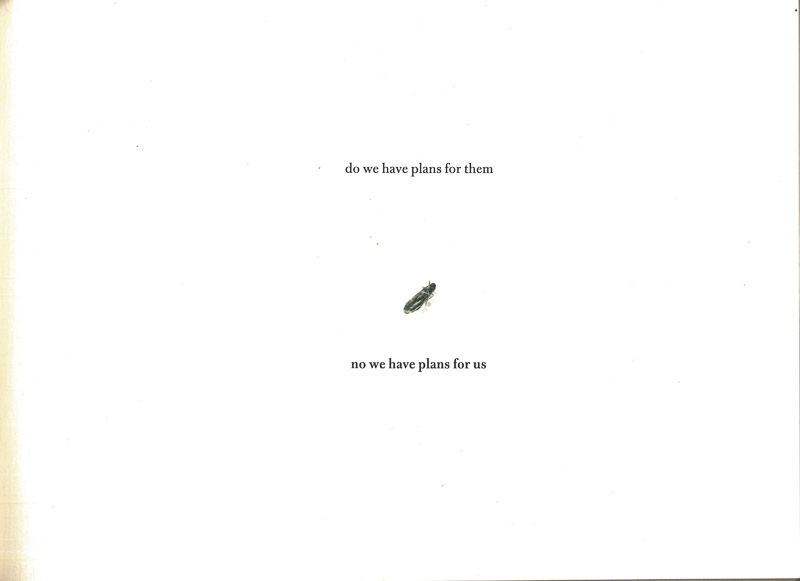 Page 79 from Wide Slumber for Lepidopterists, © a.rawlings (words), Matt Ceolin (illustrations), published by Coach House Books, 2006. Reprinted with permission from Coach House Books.
Page 79 from Wide Slumber for Lepidopterists, © a.rawlings (words), Matt Ceolin (illustrations), published by Coach House Books, 2006. Reprinted with permission from Coach House Books.
Replacing “them” with “us” is crucial, and it is the fundamental gesture of the shift from standard English to a grammar of animacy like that offered by Potawatomi — or by much of Wide Slumber for Lepidopterists. In recognizing interspecies community, we have to face that our destruction of the world around us constitutes our own destruction as well.
Imaginative and linguistic play that defamiliarizes human experience and its representation and in the process also expands our thinking to include an interspecies “we” is only that: imaginative and linguistic play. a.rawlings makes no pretense of offering her readers actual cross-species communication. Rather, as I read it, her text gives readers valuable practice in a kind of imaginative identification that resituates the human, opening conceptual channels that may yield less destructive plans for all kinds of species. To apply such perspectives beyond the textual and imaginative realms will require interdisciplinary collaboration; it will depend, that is, on challenging and expanding but not shutting off rational faculties. I have no wish to champion the approaches to scientific understanding a.rawlings critiques. Yet it seems to me unfortunate that Wide Slumber,even as it with remarkable inventiveness encourages interspecies identification, discourages interdisciplinary human communication by at least partially reinforcing easy stereotypes of scientists as destructive to life and uninterested in the intersubjectivity this book so fascinatingly explores.
1. Robin Wall Kimmerer, “Learning the Grammar of Animacy,” in Braiding Sweet Grass: Indigenous Wisdom, Scientific Knowledge, and the Teachings of Plants (Minneapolis: Milkweed Editions, 2013), 49.
5. Ibid., 58. David Abramoffers a similar view of what language might do when he proposes that “the power of language remains, first and foremost, a way of singing oneself into contact with others” — and for him those others include all kind of entities in what he terms “the animate earth.” Abram continues, “language’s primary gift is not to re-present the world around us, but to call ourselves into the vital presence of that world — and into deep and attentive presence with one another.” David Abram, Becoming Animal: An Earthly Cosmology (New York: Pantheon, 2011), 11.
6. An example of this last would be the recent uptick of interest in microbes in the human body and of microflora and microfauna in crop-growing soils. Michael Pollan, in calling attention to the multitude of microbial species that crucially help make up each of our bodies, popularizes some of this research. See, for instance, “Some of My Best Friends are Germs,” New York Times Magazine (May 15, 2013).
7. Forrest Gander and John Kinsella, Redstart (Iowa City: University of Iowa Press, 2012), 11.
8. Joan Retallack, “What Is Experimental Poetry and Why Do We Need It?,” Jacket 32 (April 2007). All quotations from Retallack derive from this essay.
9. J. M. Coetzee, Elizabeth Costello (New York: Penguin, 2004),78.
10. See Kate Soper, “Humans, Animals, Machines,” New Formations 49 (Spring 2003): 99–109, for some sensible cautions against exaggerating the value of anti-dualist perspectives or valuing the transgression of boundaries for transgression’s sake. Soper claims that it is anthropocentric not to recognize the extent of the failure of reciprocity between the human and other creatures, and urges respect for the abyss between us.
11. Val Plumwood, Environmental Culture: The Ecological Crisis of Reason (London: Routledge, 2002), 133.
13. Coetzee, Elizabeth Costello, 80.
16. Thomas Nagel, “What Is It Like to Be a Bat?” The Philosophical Review 83 (1974): 435–450. Costello claims Nagel’s “denial that we can know what it is to be anything but one of ourselves … [is] tragically restrictive, restrictive and restricted” (76). Her focus is on the powers of human sympathy, not on the nature of the animal, beyond its being, like the human, an embodied living soul.
17. Nagel’s essay is a refutation of philosophical reductionism as a viable approach to the relation of the mind to the brain, or the mind-body problem. He argues that conscious experience is a widespread experience among species, and that it has a subjective character that is not captured by any of the existing reductive analyses of the mental. He uses bats, as a species recognizably alien to the human, as an example to demonstrate the divergence between subjective and objective conception. He argues that our human ability to extrapolate the inner life of a bat from our own case is limited so that “we believe that bats feel some versions of pain, fear, hunger, and lust, and that they have other, more familiar types of perception besides sonar. But we believe that these experiences also have in each case a specific subjective character, which it is beyond our ability to conceive” (439). The subjective character of experience is fully comprehensible only from one point of view, not rendered more accessible by a shift to greater objectivity. Acknowledging that at present we have to rely on the imagination to try to think about the subjective character of experience, Nagel proposes that philosophy should attempt “to form new concepts and devise a new method — an objective phenomenology not dependent on empathy or the imagination” with a goal of at least partially describing “the subjective character of experiences in a form comprehensible to beings incapable of having those experiences” (449).
18. Nagel, “What Is It Like,” 442.
19. Plumwood, Environmental Culture, 132, 134.
21. Lorraine Daston and Gregg Mitman, Thinking with Animals: New Perspectives on Anthropomorphism (New York: Columbia University Press, 2005).
22. Here is a.rawlings’s full response to the interviewer’s question, “What made you make the connection between moths and sleep disorders?”:
Several coincidences converged … A first connection: the dictionary. On an early November day during my undergrad, I procrastinated writing an essay by thumbing through my dictionary. I was delighted to discover words new to me, mellifluous words that begged to be spoken aloud. I copied down these words: lepidopterist, littoral, macrocarpa, maquette, marram, parasomnia. Around this time, I was in contact with a high school friend of mine. Matt Ceolin was working on his masters in visual art at University of Windsor, and we took the notion to collaborate on a text-and-art project. Matt had a fascination with insects (his final ocad project, entomechology, consisted of 200+ life-size insects handmade from metal and acetate and mounted in barn-board boxes), and I was fascinated, at the time, with sleep and dream studies. The phrase “wide slumber for lepidopterists” occurred during a free-writing session and rattled around in my head for a week. The subjects intersected. What happens when a person obsessed with a subject dreams at night; does the subject matter affect how they think, how they dream, how their bodies process information? I’d been toying with this question for a while, in terms of my own tendency to write poems while dreaming. If a poet writes poems during sleep, how might a lepidopterist work while she sleeps? What effect does intimate examination of insects have on long-term information processing and subconscious behavior? A ’pataphysical question cropped up, too … What happens when you breed the vocabularies and ideas of two disparate subjects together (in my case, lepidoptery and sleep/dream studies)? What does the spawn of incompatible bedfellows resemble? From that perverse breeding, Wide slumber for lepidopterists was born. (“Coach House Books asks a.rawlings a few things about Wide slumber for lepidopterists”; ellipses in original.)
23. a.rawlings, Wide Slumber for Lepidopterists (Coach House Books, 2006), 98. Page numbers for subsequent quotations from this book appear in parentheses in this essay.
24. Thanks to some of my grad students for this insight. Though I no longer recall exactly who pointed this out, these were the wonderful members of a class on contemporary ecopoetry and ecopoetics I taught at the University of Wisconsin-Madison in fall 2010; our joint study of this book was my first extensive encounter with this text.
25. The Northern Pearly-eye that is pictured in the text, unlike many butterfly species, almost never feeds on flowers. A shade-loving butterfly found in wooded areas, it feeds on sap, dung, and mud.
26. In response to my questions about the production of the sound recordings sent to her after I had completed an early draft of this, a.rawlings wrote to me as follows:
To answer your questions, WSfL was imagined first as a visual object. I spent nearly six years crafting the page-bound version of the book. The performed version came once the book was published, and I spent about nine months with it (and working with a team of arts interdisciplinarists to bring the book from page to stage). We staged a “rough draft” of the performance (an hour in length) at Toronto’s Harbourfront Centre in November 2006. Beyond that, I adapted some of the more “sound-poetry” performance strategies to the reading that I’ve since given probably over 300 times in the last five years. This includes the breathy, throat-singing-esque “a hoosh a ha” and the insectile clicks and hisses and buzzes of “xxx y zzz thorax cervix.”
I don’t necessarily always work this way (text first, then performance). One of my current projects has the text partially penned and then performance edging around it (which then can impact the rewriting of the text and also generate new texts from the performance).
As for the recordings on PennSound, they’re comprised solely of my voice, edited using GarageBand to give an approximation of what I’d done in a few performances when working with multiple people. “Prologue” takes the first four pages of WSfL (pps. 7–10) and overlaps them. “Egg 0 Insomnia” features the first segment (pps. 14–17) with just a hint of “deep slumber” (pps. 40–41) and “bruxism” (pps. 68–71). “Apnea” combines the prologue (pps. 7–10) with apnea (p. 24) as its centerpiece and some more ephemeral “singing” sounds which I imagine run throughout this overall quite sound-oriented book. (Email to the author, July 4, 2011.)
My thanks to a.rawlings for allowing me to quote from that correspondence.
27. The book’s thematic investment in staged metamorphosis is marked even via the visual symbols used to identify supplementary sections like the glossary, appendix, and colophon, since these represent the moon at different stages.
28. Email to the author, July 4, 2011. She continues, “I can understand a certain amount of ‘false advertising’ perhaps evident in the back-cover copy at this juncture (and also with the ‘you, you, you’ that peppers the copy when the book has been carefully written solely with ‘us’).” This book is hardly unusual in having the language of the back cover (e.g., “Pattern your breath on the sound of moth wings, magnified and frenzied, as you fight for sleep …”) more designed to draw in readers than to represent the text with accuracy.
29. My perspective here will not be shared by all readers. The only article published to date on this book, Erin Gray’s insightful “‘The good sentences of sleep’: Parasomnia and ’Pataplay in Rawlings and Legris” (Open Letter 13, no. 9 [Summer 2009]: 153–65) focuses on how the text represents sleep as “a sensuous practice and a source of knowledge rather than a passive state of withdrawal” (154). Our readings coincide in Gray’s claim that “sleep is placed at the centre of this interspecies and interdiscursive confrontation in order to interrupt the commonly-held epistemic division between observer and observed” (156), but Gray reads quite differently than I do in terms of a human-focused narrative that “illustrates the violence of sleep disturbances”: “Wide Slumber could be characterized as the transcripted result of a Lepidopterist’s visit to the sleep specialist. But rather than replicate the dry rhetoric of clinician-speak, Rawlings filters the language of sleep science through the unconscious remains of a day spent as laboratory head rather than rat.” Gray sees the Lepidopterist’s body becoming “entrapped in the violence of dyssomnia” (157). For me, the volume has less narrative coherence and is less human-centered, while its violence is as much a potential inherent in language as it is a quality of sleep disturbance.
30. Retallack insists (and I value this insistence) on the importance of gaining knowledge about other species, presumably in large part through the tools of science, as essential to pursuit of a two-way otherness. And here she and a.rawlings at least in some ways part company. The book’s warning against rational science, the most accessible part of the text, is also the most conventional. Where a.rawlings’s project seems to me most interesting is not in its warnings to avoid semanticide but in the strategies it uses to create all sorts of potentially meaningful arrangements of words identifying species and body parts and food sources, its creation of a different kind of ecology.